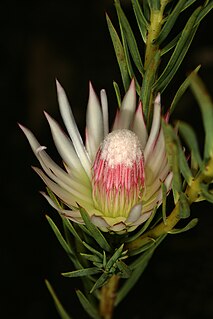
The International Union for Conservation of Nature (IUCN) Red List of Threatened Species, founded in 1964, is the world's most comprehensive inventory of the global conservation status of biological species. It uses a set of precise criteria to evaluate the extinction risk of thousands of species and subspecies. These criteria are relevant to all species and all regions of the world. With its strong scientific base, the IUCN Red List is recognized as the most authoritative guide to the status of biological diversity. A series of Regional Red Lists are produced by countries or organizations, which assess the risk of extinction to species within a political management unit.

Cypress is a common name for various coniferous trees or shrubs of northern temperate regions that belong to the family Cupressaceae. The word cypress is derived from Old French cipres, which was imported from Latin cypressus, the latinisation of the Greek κυπάρισσος (kyparissos).

The conservation status of a group of organisms indicates whether the group still exists and how likely the group is to become extinct in the near future. Many factors are taken into account when assessing conservation status: not simply the number of individuals remaining, but the overall increase or decrease in the population over time, breeding success rates, and known threats. Various systems of conservation status exist and are in use at international, multi-country, national and local levels as well as for consumer use.

Silene dioica, known as red campion and red catchfly, is a herbaceous flowering plant in the family Caryophyllaceae, native throughout central, western and northern Europe, and locally in southern Europe. It has been introduced in Iceland, Canada, the US, and Argentina.

Gallotia simonyi, also known as Simony's lizard, is a species of lacertid that was found on many of the Canary Islands. The species was once present throughout much of the islands, but one of the two subspecies is extinct, while the other, the Roque Chico de Salmor giant lizard is now confined to a few small areas of cliff with sparse vegetation. It is currently restricted to the southern end of the Risco de Tibataje in la Fuga de Gorreta, located between Guinea and the so-called Paso del Pino. The species was also successfully reintroduced to the Roque Chico de Salmor in 1999, and subsequent reintroductions have taken place at Julan and at la Dehesa.(Miras & Pérez-Mellado 2005b)
Tectiphiala ferox, or palmiste bouglé, is a species of flowering plant in the family Arecaceae. It is endemic to Mauritius.

Helicia is a genus of 110 species of trees and shrubs, constituting part of the plant family Proteaceae. They grow naturally in rainforests throughout tropical South and Southeast Asia, including India, Sri Lanka, Indochina, Peninsular Malaysia to New Guinea and as far south as New South Wales.
Silene biafrae is a species of plant in the family Caryophyllaceae. It is endemic to Cameroon. Its natural habitat is subtropical or tropical dry lowland grassland.

Silene diclinis is a species of plant in the family Caryophyllaceae. It is endemic to Spain. Its natural habitat is pastureland. It is threatened by habitat loss.
Silene fernandezii is a species of plant in the family Caryophyllaceae. It is endemic to Spain. Its natural habitat is rocky areas. It is threatened by habitat loss.
Silene gazulensis is a species of plant in the family Caryophyllaceae. It is endemic to Cádiz, Spain. Its natural habitat is rocky areas. It is threatened by habitat loss.

Silene hicesiae is a species of plant in the family Caryophyllaceae. It is endemic to Panarea and Alicudi, which form part of the Aeolian archipelago, a commune of Sicily, Italy. Its natural habitats are Mediterranean-type shrubby vegetation and rocky areas. It is threatened by habitat loss.

Silene sennenii is a species of plant in the family Caryophyllaceae. It is endemic to Spain. Its natural habitat is Mediterranean Matorral shrubland vegetation. It is threatened by habitat loss.
Erodium astragaloides is a species of flowering plant in the geranium family Geraniaceae. It is endemic to Sierra Nevada, southern Spain.

Protea mucronifolia, the dagger-leaf sugarbush, is a flower-bearing shrub belonging to the Protea genus. The plant is endemic to the Western Cape where it occurs from Hermon to Saron. This is the only population. The shrub grows upright and grows 1 m tall and flowers from October to January with the peak from November to December.
Silene longicilia is a species of flowering plant of the family Caryophyllaceae. It is endemic to Portugal.

Spatalla longifolia, the pink-stalked spoon, is a flower-bearing shrub that belongs to the genus Spatalla. It forms a part of the fynbos. The plant is native to the Western Cape where it is found in the Hottentots-Holland Mountains; from Franschhoek and Villiersdorp to the Kleinmond Mountains.
Paranomus adiantifolius, the hairy-style sceptre, is a flower-bearing shrub that belongs to the genus Paranomus and forms part of the fynbos. The plant is native to the Western Cape, South Africa.










